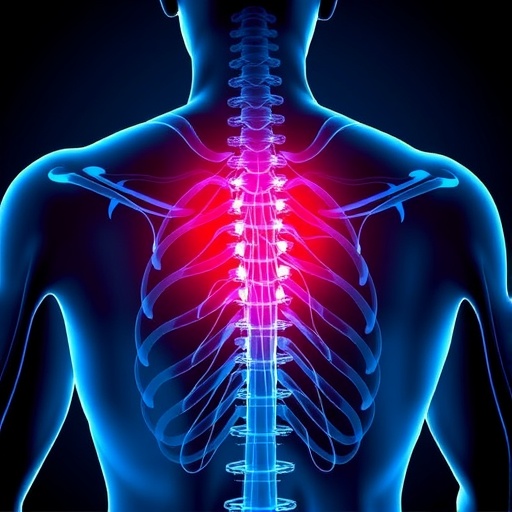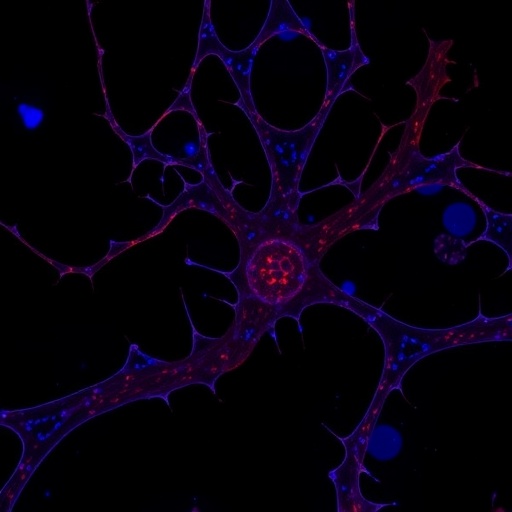In a groundbreaking study published in Nature Communications, researchers have unveiled a novel approach to tackling inflammatory pain that challenges long-standing assumptions about the relationship between pain and inflammation. The team led by Nassini, Landini, and Marini has discovered that selectively targeting prostaglandin E2 receptor 2 (EP2) in Schwann cells—a type of glial cell found in the peripheral nervous system—can dramatically suppress inflammatory pain without affecting the underlying inflammatory processes themselves. This nuanced finding opens unprecedented therapeutic avenues that could revolutionize pain management, offering relief without the collateral consequences associated with broadly suppressing inflammation.
For decades, prostaglandins—lipid compounds derived from arachidonic acid—have been recognized as central mediators of both inflammation and pain. Prostaglandin E2 (PGE2), in particular, operates through a quartet of G-protein coupled receptors (EP1-EP4), each orchestrating distinct physiological reactions. Despite known involvement in pain pathways, the discrete cellular mechanisms through which PGE2 modulates pain, especially in peripheral nervous system components like Schwann cells, remained elusive. The current study elucidates these mechanisms by marrying sophisticated molecular biology techniques with in vivo pain and inflammation models.
Schwann cells, often overshadowed by the neurons they envelop, play crucial roles in peripheral nerve function and repair. This research highlights that Schwann cells express EP2 receptors abundantly and that activation of these receptors significantly contributes to the sensation of inflammatory pain. By genetically or pharmacologically inhibiting EP2 receptors specifically in Schwann cells, the researchers observed a pronounced reduction in hyperalgesia—heightened pain sensitivity—in mouse models exposed to inflammatory agents. Intriguingly, this inhibition did not alter the levels or progression of inflammation itself, as measured by classical markers such as cytokine expression and tissue swelling.
This paradoxical dissociation between pain perception and inflammatory response challenges the dogma that inflammation and pain are inextricably linked and governed by the same molecular circuits. The findings suggest that pain, while often a cardinal symptom of inflammation, can be uncoupled on a cellular level, enabling targeted alleviation of pain without compromising the body’s innate inflammatory defense mechanisms. This potential paradigm shift has enormous clinical implications, especially considering that many current analgesics, including nonsteroidal anti-inflammatory drugs (NSAIDs), can interfere with inflammation resolution and provoke serious side effects.
Delving deeper into the signaling pathways, the team employed transcriptomic analyses and electrophysiological recordings to characterize the downstream effects of EP2 receptor modulation in Schwann cells. The blockade of EP2 attenuated the release of pro-nociceptive mediators such as nerve growth factor (NGF) and interleukin-6 (IL-6) from Schwann cells, which are known to sensitize nearby sensory neurons. Furthermore, the study identified that EP2 receptor antagonism dampens Schwann cell hyperexcitability, thereby reducing the amplification of pain signals transmitted to the central nervous system. This multifaceted role underscores Schwann cells as active participants rather than passive bystanders in the pathophysiology of pain.
From a translational perspective, these insights pave the way for the development of highly selective EP2 receptor antagonists that could serve as novel analgesics with minimal impact on inflammation. Given the global burden of chronic inflammatory pain conditions such as rheumatoid arthritis, neuropathy, and post-surgical pain, therapies derived from this research could dramatically enhance patient quality of life. By circumventing the adverse effects of current pain treatments that indiscriminately suppress inflammation, clinicians could offer targeted relief tailored to neuronal-glial interplay.
Additionally, this study raises provocative questions about the role of Schwann cells and EP2 receptors in other pain modalities, including neuropathic and cancer-related pain syndromes. Since Schwann cells modulate axonal conduction and nerve regeneration, selective targeting of EP2 might also influence the chronicity and resolution phases of pain. Future investigations are poised to dissect these complex interactions, potentially uncovering a broader spectrum of conditions amenable to EP2-targeted therapies.
Equally important is the methodology employed, combining genetic manipulation with state-of-the-art in vivo imaging and behavioral assays. This integrative approach provided a comprehensive understanding of the cell-specific contributions to pain, setting a precedent for future pain research frameworks. By isolating the Schwann cell EP2 receptor axis, the authors highlight the value of cellular precision medicine in neurological therapeutics, a strategy likely to gain momentum in the coming years.
Moreover, the study meticulously corroborates the specificity of EP2 receptor targeting by ruling out compensatory changes in other prostanoid receptors and inflammatory mediators. This rigorous validation reinforces the conclusion that Schwann cell EP2 receptors constitute a distinct gateway to modulate pain independently of canonical inflammatory cascades. It underscores the sophistication of intercellular signaling in the peripheral nervous system and hints at untapped therapeutic targets lying within traditionally overlooked glial populations.
The impact of these findings transcends the immediate field of pain research. They may inform the development of tailored treatment regimens incorporating EP2 receptor antagonists alongside existing therapies to optimize pain control while minimizing systemic immunosuppression. This is particularly relevant in vulnerable populations such as the elderly or those with autoimmune disorders, who often experience adverse reactions to broad-spectrum anti-inflammatory agents.
In addition, the selective targeting approach could reduce the risk of opioid use and dependence by providing alternative mechanisms to mitigate inflammatory pain. The opioid crisis underscores the urgent need for novel, non-addictive analgesics, and EP2 receptor antagonism in Schwann cells emerges as a promising candidate in this quest. Moreover, understanding how selective inhibition affects neuronal-glial communication expands the fundamental knowledge of pain neurobiology, informing drug discovery pipelines.
Notably, the study opens intriguing perspectives on the evolutionary basis of pain and inflammation. By uncoupling pain from inflammation at a cellular receptor level, it prompts reconsideration of the adaptive functions of pain in the context of tissue damage and immune response. Separating these signals might have profound consequences for how organisms perceive and respond to injury, potentially guiding more nuanced therapeutic interventions that respect the biological complexity involved.
While the research presents compelling evidence from animal models, the authors acknowledge the necessity of clinical studies to validate these findings in human subjects. Translational hurdles include ensuring selective receptor targeting, pharmacokinetics, and potential off-target effects. Nonetheless, the clarity of the mechanistic insight offers a robust foundation for drug development endeavors. Collaborative efforts between academia, industry, and clinical practitioners will be vital to move this promising discovery from bench to bedside.
In summation, Nassini and colleagues have delivered a paradigm-shifting contribution to our understanding of inflammatory pain and its dissociation from inflammation. By pinpointing the prostaglandin E2 receptor 2 in Schwann cells as a critical node in pain modulation, they have unlocked a powerful target for next-generation analgesics. The implications for patient care, pharmaceutical innovation, and basic neuroscience are profound, signaling a new era in pain management that prioritizes specificity, efficacy, and safety.
As scientific inquiry continues to unravel the complexities of peripheral pain pathways, this study stands as a landmark, highlighting the therapeutic promise of glial biology in pain modulation. The findings urge a reconsideration of how pain is conceptualized and treated, ultimately fostering hope for millions burdened by chronic inflammatory pain worldwide. The journey to harnessing this revelation into tangible clinical benefits is just beginning, but its potential is nothing short of transformative.
Subject of Research: Mechanistic investigation of prostaglandin E2 receptor 2 in Schwann cells and its role in inflammatory pain modulation independent of inflammation.
Article Title: Targeting prostaglandin E₂ receptor 2 in Schwann cells inhibits inflammatory pain but not inflammation.
Article References:
Nassini, R., Landini, L., Marini, M. et al. Targeting prostaglandin E₂ receptor 2 in Schwann cells inhibits inflammatory pain but not inflammation. Nat Commun 16, 8262 (2025). https://doi.org/10.1038/s41467-025-63782-8
Image Credits: AI Generated
Tags: EP2 receptor and inflammationG-protein coupled receptors in inflammationgroundbreaking study on prostaglandinsinflammatory pain managementlipid compounds in pain signalingmolecular biology in pain researchnovel pain relief strategiesperipheral nervous system pain mechanismsprostaglandin E2 receptor 2 targetingSchwann cells in painselective pain modulationtherapeutic avenues for pain relief




